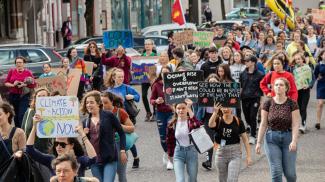Investing in green initiatives is a win-win, argues Alicia Fernanda Galindo Manrique.

The economic impact of environmental pollution amounts to more than $350 billion, although the OECD estimates that it will reach $3,300 billion by 2060. Its biophysical costs have a direct impact on health, labor productivity, and agricultural yields.
Policies that counteract environmental damage, while reducing the biophysical and economic costs of pollution, could include attractive incentives for the use of clean energy and technologies. In most cases, these actions are seen as costs rather than investments and yields, and as components of risk management, rather than its mitigation.
However, the need for the creation of investments that reduce emissions, adaptation to climate change, and the search for opportunities in the transition to low-carbon economies is greater than ever. Industry now has the opportunity to grow sustainably thanks to the development, production, and use of more affordable low-carbon (low-carbon emission) technologies, services, and systems.
The Paris Agreement on Climate Change signed in 2015 and the UN Sustainable Development Goals have set the tone for generating markets that are more resilient to climate change and less intensive in carbon emissions generation. Nevertheless, this requires higher levels of investment and the consolidation of a new branch of finance known as green finance, which refers to investments in technology, infrastructure, and environmental services.
The United Nations Framework Convention on Climate Change (UNFCCC) defines green or climate finance as local, national, or transnational financing for the significant reduction of emissions in sectors that are the biggest greenhouse gas contributors.
Green finance and markets can help to fulfill long-term sustainable growth strategies by:
- Increasing seed capital for marketing innovative clean technologies.
- Supporting the development of a new range of products that will facilitate and deliver low-cost energy efficiency measures.
- Mobilizing large-scale investments in the automotive manufacturing sector to produce low-emission vehicles.
- Ensuring that the financial sector is resilient to climate change and, above all, that investors consider environmental factors.
- Offering greater diversification in, for example, green bonds and infrastructure.
Nevertheless, green finance and markets are still in the early stages, but with the potential for growth.
Long-term climate risks can be summarized as higher production costs from the increase in input (energy and water) prices, abrupt changes in energy prices, adjustments to the prices of commodities such as fossil fuels, and decreased demand for products and services owing to changes in consumer preferences. All of this represents opportunities in financial markets, but the lack of information in companies could take attention away from investments that are key to sustainable growth plans.
A Profitable Market
According to the Sustainable Stock Exchanges Initiative (SSE), $90 trillion need to be invested by 2030 to achieve sustainability goals. In 2018, more than $3.3 trillion were mobilized in environmental investments, with the global green bond market having reached $155.4 billion in comparison with the previous year, and assets managed in clean energy multiplied their growth to $335 billion. These figures reveal a growing, profitable market.
Institutional investors describe climate change as a long-term trend that represents a risk for their investments. Capital cities such as Dubai, Hong Kong, London, Luxembourg, Paris, and Singapore have taken advantage of this situation and converted their financial centers into internationally benchmarked sustainable green markets, which benefits stock exchanges in diverse contexts:
- Attracting new green OPIs and financial products
- Generating state-of-the-art as a transitioning market
- Meeting investors’ demand for green products and services
- Consolidating their position in the global economy by supporting climate action goals
In fact, sustainable indices, according to the SSE, have performed better than than their benchmarks in the past few years. An example is the FTSE All-World Climate Balanced Factor Index, which uses financial asset diversification to address the risks and opportunities associated with climate change. The aim of this index is to reduce the exposure of companies that are related to the production or exploration of fossil fuels and companies that emit high levels of CO2. Furthermore, this index increases exposure to companies that produce goods and services that reduce environmental erosion, resource shortage, and ecological impacts. The accumulated yield in 5 years is 46.9%, and implied volatility 10.3%. Currently, it is made up of 2,023 issuers and offers a 2.98% dividend yield.
The yields achieved have shown the win-win situation in green investments, not only owing to their financial benefit, but also the social benefit for our community and country, thereby ensuring a better world for future generations. Even though the challenge is enormous, the benefits have great potential, and it is a gamble that is worth taking.

